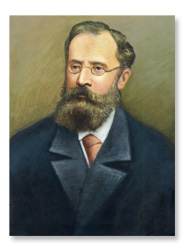Balakirev soon met another like-minded young man, Cesar Cui, and over a few years three more joined the group: Modest Mussorgsky, Nikolai Rimsky-Korsakov, and Alexander Borodin. The men were all young. By the time all five had been assembled, the oldest was 28 and the youngest 18.
.jpg/200px-Milij_Aleksejevi%C4%8D_Balakirev_(%D0%9C%D0%B8%D0%BB%D0%B8%D0%B9_%D0%90%D0%BB%D0%B5%D0%BA%D1%81%D0%B5%D0%B5%D0%B2%D0%B8%D1%87_%D0%91%D0%B0%D0%BB%D0%B0%CC%81%D0%BA%D0%B8%D1%80%D0%B5%D0%B2).jpg) Balakirev was the undisputed leader of the group, but this did not mean he dictated how the other members should compose. Each composer developed their own highly individual style, though they all agreed on the group's founding tenet--to write music inspired by the melodies, harmonies, and rhythms of Russian folk music. For some, like Rimsky-Korsakov, this meant incorporating Russian history and folk legends, as demonstrated by his large number of operas, including one based on and named after the folk hero Sadko, and another based on Ivan the Terrible entitled The Maid of Pskov.
Balakirev was the undisputed leader of the group, but this did not mean he dictated how the other members should compose. Each composer developed their own highly individual style, though they all agreed on the group's founding tenet--to write music inspired by the melodies, harmonies, and rhythms of Russian folk music. For some, like Rimsky-Korsakov, this meant incorporating Russian history and folk legends, as demonstrated by his large number of operas, including one based on and named after the folk hero Sadko, and another based on Ivan the Terrible entitled The Maid of Pskov.
Mily Balakirev
Rimsky-Korsakov in 1863, shortly after joining The Five
The Five wanted to spread Russian music around the globe, and to a point, they succeeded. While only a small number of works produced by members of the group have entered the repertory worldwide, most of their works enjoy a permanent place on concert programs in Russia. Nevertheless, performance is not the only gauge of influence. Many of the group's successors were heavily influenced by this 'alternative' to traditional classical music, and some of them went on to be the biggest composers of the 20th century. Among those influenced include Russian composers Igor Stravinsky, who was taught by Rimsky-Korsakov, Sergei Prokofiev, Alexander Glazunov, and Dmitri Shostakovich. And beyond Russian composers, the two best known French composers, Claude Debussy and Maurice Ravel, were inspired by The Five's use of 'exotic' scales and harmonies, and unconventional approach to modulation and form.
Ravel even orchestrated Mussorgsky's now well known piano work Pictures at an Exhibition. The piece is inspired by the paintings of Viktor Hartmann, who was Mussorgsky's personal friend, and one of the first painters to use Russian motifs in his work. Mussorgsky's work romanticizes Russian peasant life, among other things, and several of the movements depict Russian themes explicitly, such as the last two movements Baba Yaga's Hut on Fowl's Legs and The Great Gate of Kiev.
Modest Mussorgsky
Due to the low status classical music held in Russia at the time, most members of the The Five were not composers by profession, or took a long time to become financially independent as musicians. Alexander Borodin was a chemist, and a good enough one to be co-credited with discovering the Aldol Reaction. Still, his music was of a very high quality, ripe with lush harmonies and lyrical melodies. Borodin is the only member of The Five who took a serious interest in writing chamber music. The others looked down upon it, but Borodin's string quartets are some of the best in the genre.
Cesar Cui was also an 'amateur' composer, as his full time career was that of an army officer who specialized in, and published books about, 'fortifications'. Cui also produced huge amounts of musical criticism that helped to define Russian musical values. In his criticism, Cui was usually very negative towards Russian composers whom he felt conformed to the Western style, especially Tchaikovsky, and even occasionally a member of The Five received a lashing. Cui is best known for his 15 operas and many art songs, all of which emphasize his literary bent.
It is ironic that The Five arose in the time period that they did. In this late stage of Imperial Russia, the individual was becoming more prominent, what with Turgenev, Pushkin, and Tolstoy ushering in the Romantic and Nationalist era. It is strange that a group of men, who in themselves are surely individual, should be so strongly associated with one another in one of the few time periods an individual could exist in Russia.
Here is an excerpt from Mussorgsky's Pictures at an Exhibition. This is the last scene, known as "The Great Gate of Kiev". This is the version orchestrated by Ravel. The music is typical of the Russian-Nationalist style advocated by The Five, and features progressions alien to traditional western music, and other voice leading irregularities, such as parallel fifths. Notice the lush, dramatic chords.


No comments:
Post a Comment